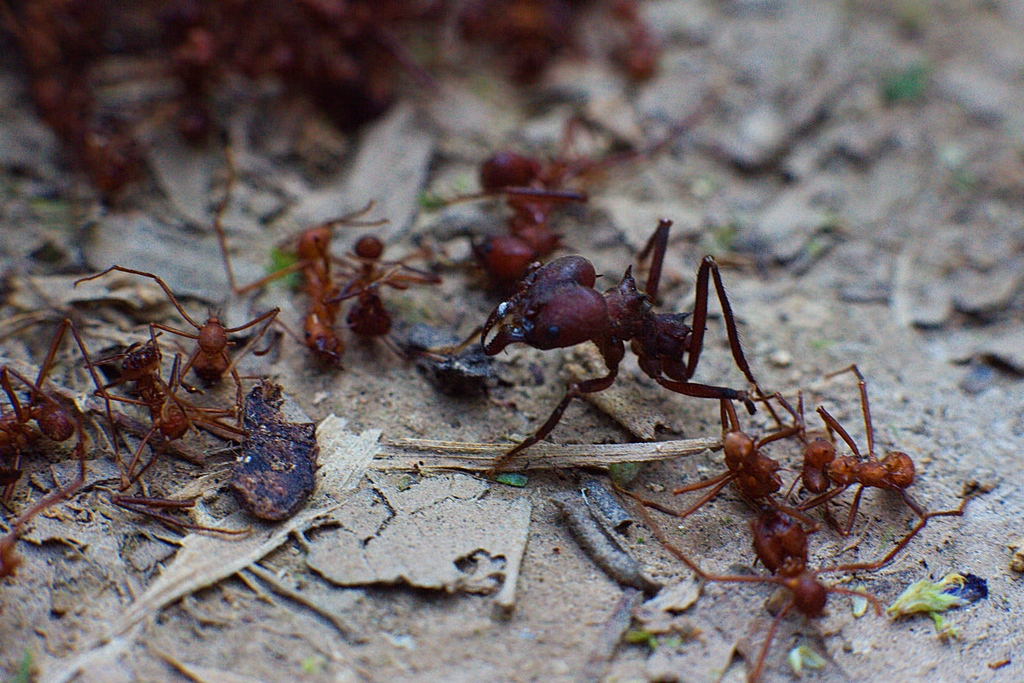By Dessa Bayrock (The Cascade) – Email
Print Edition: February 19, 2014

Fire ants have never been humanity’s favourite insect.
The species has a few distinctive, ugly features: they’re larger than the average ant, they have an excruciating sting, and to make matters worse, they swarm to attack — meaning that if you get stung by one fire ant, chances are there are a few dozen more on their way up your leg.
But people aren’t the only ones harbouring dislike for fire ants. Other insects are even more wary of fire ants, which smear venom — effectively a natural insecticide more powerful than DDT — on their enemies to disable and kill them.
Now there’s a new ant edging in on fire ant territory in the southeastern areas of the U.S. which might just be bad news for both fire ants and people.
In a study from the University of Texas at Austin (UT) published in the journal Science Express, three researchers discovered that crazy ants have the ability to neutralize fire ant venom. In times of need, they secrete an acid; by smearing it on affected areas they render fire ant venom useless.
Alongside researchers Nathan Jones and Lawrence Gilbert, Ed LeBrun co-authored the study as part of his work with UT’s invasive species research program.
To get a look at a battle between the two species, LeBrun placed a dead cricket between fire ant and crazy ant territory and sat back to see what would happen.
Despite a swarm of fire ants claiming the food first, the crazy ants leaped into the battle.
“The crazy ants charged into the fire ants, spraying venom,” LeBrun said to KXAN in Austin.
“I thought they were making kamikazi (sic) runs,” he later told the Houston Chronicle. “But when they got smeared with fire ant toxin, a fate that should have been lethal, they went off to the side.”
Once safely out of the way, the crazy ants curled up to touch their mouths to their abdomens and ran their mouths over their limbs. Once they completed this routine, the ants went right back into battle.
This odd behaviour left LeBrun scratching his head, so he pulled the two species into the lab to get a better look at what was happening.
The researchers discovered that crazy ants had a 98 per cent survival rate against fire ant venom. When the researchers sealed the crazy ants’ abdominal glands with nail polish, they were unable to completely neutralize the venom — the survival rate dropped to about 50 per cent.
The rivalry between the two species is still relatively new to the States, but both ants are native to the same areas in South America. This is only the latest stage of what the UT press release refers to as “an ancient evolutionary arms race.”
But LeBrun has no doubt how the U.S. installment of this rivalry will end.
“As this plays out, unless something new and different happens, crazy ants are going to displace fire ants from much of the southeastern U.S. and become the new ecologically dominant invasive ant species,” he said.
There is both good and bad news in this for humans. The upside is that crazy ants don’t share the painful fire ant sting, meaning that they aren’t as unpleasant to deal with. Crazy ants also spread and colonize slower than fire ants, which makes them a little easier to contain.
The bad news is crazy ants are also talented at stowing away; their natural spread might be slow, but it’s significantly sped up by people.
Crazy ants nest opportunistically in any cavity they can find,” LeBrun told KXAN. “That includes things like potted plants, plywood left around, recreational vehicles. People are just moving around these ants like gangbusters.”
Crazy ants also have an effect on the natural ecosystem. As an invasive species, they eat food that would normally sustain other insects or animals — and sometimes those local insects or animals are on the crazy ant menu as well, and have to learn how to live with a new predator on the block.
The consequences are felt all the way up the line to humans, namely in the creatures we use to pollinate our food.
Exterminator Tom Rasberry first saw crazy ants in Pasadena over a decade ago.
“Beekeepers are going crazy over these ants,” he told the Houston Chronicle. “They decimate honeybees.”
While there are insecticides that can control crazy ant populations, none of the options are affordable — meaning that if we don’t watch ourselves, we might be stuck with crazy ants for a long, long time.

